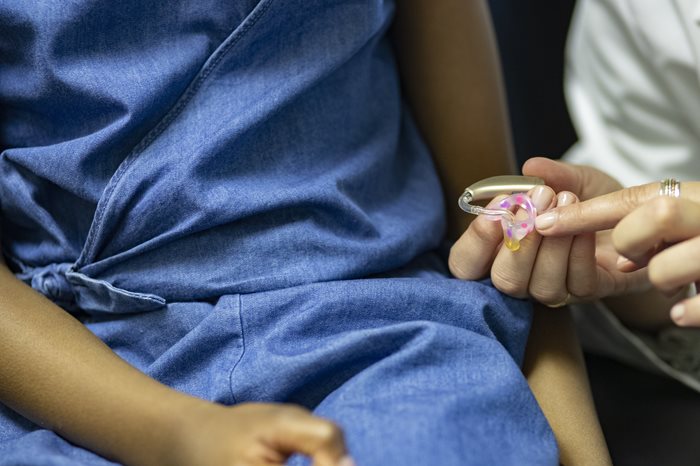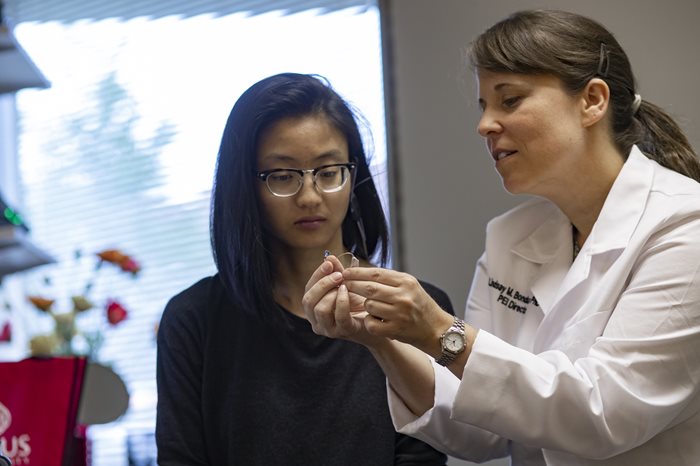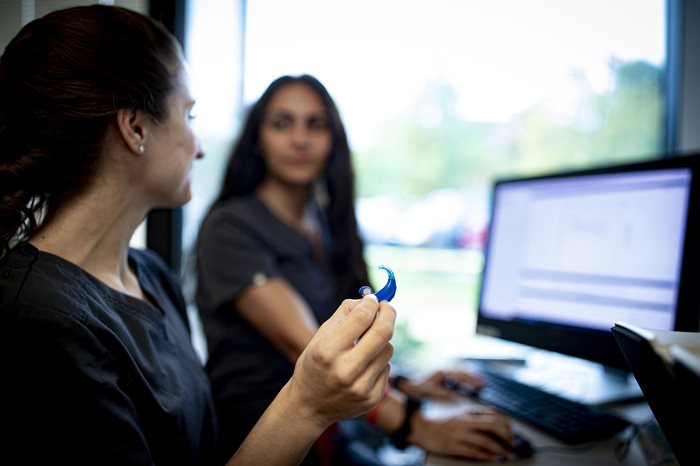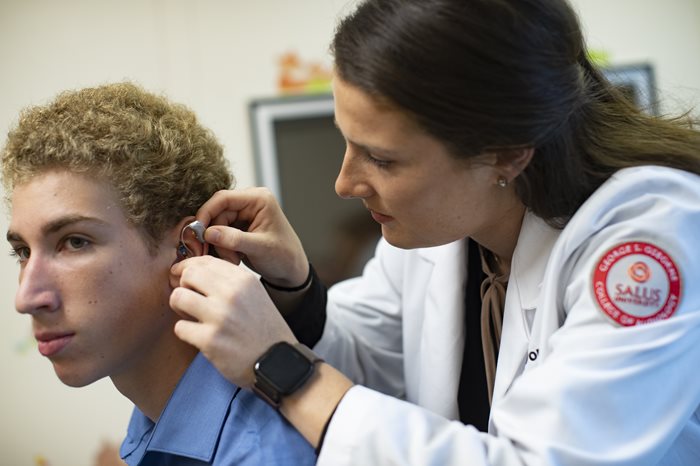Join Aaron Roman, AuD, CCC-A, FAAA, assistant professor in the Osborne College of Audiology (OCA) at Salus University and clinical audiologist at the Pennsylvania Ear Institute (PEI), as he discusses the role of the hearing aid industry, particularly hearing aid industries and their involvement with audiology education. He is joined by Victor Bray, MSC, PhD, FNAP, OCA associate professor, who will bring some insight into the benefits of partnering with the hearing aid industry.
Bray: Being an old timer, I have been in a lot of places in audiology. I started out in clinical care, and that was the first third of my career. As a clinician, I observed some significant changes in patient performance that was tied to some breakthroughs in technology and left academia to go work with a really great American startup company called ReSound, and went into their R&D team and worked with them for several years. From there I had a chance to work with another great startup American company, SONIC Innovations. We were the first company that came out that was all digital hearing aids, never made analog hearing aids.
I worked with them for a dozen years and left SONIC to come here to Salus University. I was recruited to come in as the dean of the college and did that for six, seven years and since then I've been a full-time faculty in a teaching role. I teach about 20 different courses, covering a wide range. Clearly my emphasis and interest is in hearing technologies, which is a year-long sequence. But I also teach geriatrics, and I teach a course for incoming students on study skills. I teach a course for our students who are preparing for externship, which is on resume writing. Also, for our students, a course on ethics. Another course on professional issues. And for our third-year students who are preparing for the national exam, I teach the Praxis review. So, a lot of different courses. It's probably about 20 different courses that I teach over the course of a year. It's really an interesting and widespread array of topics that I get a chance to engage with our students.

Roman: Given all of your experiences, can you tell me a little bit about how you bring the hearing aid industry into your teaching? How do you incorporate either these partnerships or your experiences into the classroom?
Bray: Every audiology program, and the professors who teach the hearing technologies courses, is faced with a challenge of how much are you going to engage with industry? Some programs take the attitude that we really don't want industry on our campus. We want all the information to come from our students. I'm on the other side of the coin. Having spent a third of my career in industry, I realize there's a lot of value in the people who work in industry and particularly the trainers. I work on actually bringing the trainers into our classroom. And the way we have the course structured in our first term, we learn all about the technologies from a generic point of view.
We learn the theory and the generic applications in words having to describe that, but when we get to the third term, the students are faced with going off-campus and starting to work specifically with one of the six major brands that are out there. And those companies don't speak in terms of generic technologies, they have their own names for how their technology implementations are. They have their own way that their specific algorithms are implemented, and they have their own programming systems. Every one of these companies has a unique platform and portfolio.
The goal in that we really partner with industry is bringing them in for this third course, so the students have a chance to learn how all six companies set up their products, set up their portfolios, set up their programming systems, so that when they go off-campus and they walk into any clinical rotation, depending on what company that clinic works with, they've already had a really good advanced look to the technologies and they're not walking in blind into that clinical situation.

Roman: What are some of the other values that you can see, how it translates either into traditional didactic education or clinical education in incorporating these partners?
Bray: There's a couple of things that I think are really important that we emphasize in our courses here. It's a difference between understanding how and understanding why. If we're training technicians, all we have to do is to teach them how to push a button, because a lot of systems are automated now in audiology. We have very good machine learning and protocols running on the computers. And that's a role of a technician. But not everything will work on the standardized approach. And so, by teaching doctors in the healthcare system, we're teaching them why things work, so that they can actually go in and solve problems when the nonstandard approach doesn't work.
That understanding of why is critical to combine with how do I go about doing it. Now, on the industry side when we bring in our guest speakers, as somebody who did that as part of my career, going out and speaking to many, many different groups, I know that my job as a representative is to put my company in the position that it looks great and fantastic and the audience has no question why they shouldn't be choosing me as their provider of choice.
I also understand as a former person who does this, part of my presentation is fact-based, and part of it is icing on the cake to make me look unique. By virtue of the background that I have, I can work with our students to separate, this is strong phase, but fact from fiction. What is it that we're actually discussing and let's tie that back to the generic applications of the technology that we learned in our first term. Now, from that, let's separate out from what's the hyperbole that says this is the best, this is unique, this is something that we do better than anybody else. And frankly, once the students listen to six presentations and they hear each one talk about, "We're the best. We're the only. We're the unique," they start to develop this sensitivity and awareness that everybody has a marketing spin on top of their training talk. We need to be able to set that aside and critically evaluate what we're working with in terms of the technology.
I have to compliment my teaching colleague, Dr. Rebecca Blaha. She teaches a clinical skills lab that is taught in parallel with my lecture courses. Whenever we can, the week after we have a company trainer come in and say this is our product portfolio and this is our programming system, she actually runs a lab where we work with their hearing aids and we run the hearing aids through a rigorous protocol evaluating product performance, to actually evaluate the claims that were made in the lecture sessions.
And so, at the end of that, we do a critique of the product, how well does it perform, what about the programming system, what are the nuances, what's the flow. Again, the goal is really to prepare our students, not only for where they are today, but where they are going to need to be a year from now when they're off-campus in their clinical rotations.

Roman: So, in addition to teaching audiology skills related to hearing aids, you're almost teaching the psychology of marketing to understand what the reps are saying to you and how to wade through what they're saying to get some more of the evidence that you can use to implement into that practice.
Bray: I think that's a very good point. It's important for all audiologists to realize when you have a company spokesman speaking to you, their job is to tell you why you should do business with their company and not someone else. And again, this aspect of how and why. You have to understand why things work, how their implementation is, and to be able to make your own judgment on what is going to work for your practice and your patients. And developing that awareness while they're in school makes them stronger clinicians going out in their clinical rotations in their third and fourth year.
Roman: Like evidence-based practice, right? You learn to read the evidence but you learn to apply it to the patient and based off of your own psychological values.
Bray: I'm so glad you brought that up. We do teach evidence-based practice and there's an aspect of that that's so critical to bringing the trainers in. The reason I went out of clinical care and into industry was to learn about what we could develop and what we could make and what we could bring to market that would be breakthroughs. So, when I talked in that role and when I went out and talked to clinicians about what they were doing, I realized I was often three to five years ahead of them in awareness. When I look at the trainers who are coming in, they're learning about what is happening right now. These are the current products, this is our current programming system. And if you wait for the evidence-based publications that evaluate the products and the systems, you're not going to get your hands on that information in terms of publications for a minimum of two to three years down the road.
Our students have to be able to hit the ground running with what's there right now. So, let's teach, what's the evidence-based practices that you can perform as a clinician so you can do your own evaluations, and then apply that principle so that you're looking at the products and you can use them in a knowledgeable manner. Again, separate out what actually works from what it says it might work, which may or may not be how it actually does.
But, your point is critical. The way we have it structured, these are the concepts, this is the implementation, now test the implementation, and let's come together as a group and evaluate what we've just seen. We build our own internal evidence base so that the students can move ahead in a factual manner.
Roman: In your experience, have you ever encountered any challenges in incorporating these partnerships or any difficulties with translating this into the classroom?
Bray: There are some challenges. One is in my preparation for our guest speakers coming in, having them understand that this is not a marketing workshop. This is an educational workshop. The other thing is to have the students understand that when they listen to the presentation not everything they hear is necessarily fact-based. So, there's opinion, all the slides are prepared by the marketing department. We have to get into what's the science, the hearing aid science behind all this. By the end of the term, when we've had a half dozen presentations, we've developed in the students the sensitivity to separate out the marketing materials from the scientific basis.
When we do that, and accomplish that by the end of the term, the students are learning to discriminate how to read and listen to the information. That's critical. And then, on the trainer side and I've got to really thank them, because I'm asking them not to give their standard training presentation, but to alter it for our needs. What I've done is, I've developed and we utilize a “20 questions” document. And what are the things that are important for the students to learn. That's the science, not the marketing message. And I give that “20 questions” document to the trainers in advance to say, "This is what the students have to learn from your presentations." I also give that to the students saying, "This is what you have to learn," and it's the basis of their homework assignment. And, "If you did not get answers to these key questions in the presentation, use the Q&A session to follow up and ask the guest speaker."
It gives the presenter and the students guidelines of where's the science and where's the evidence base to move ahead if you're going to work with this company and their products.

Roman: It sounds like it's a quite a bit of preparation on your end as well as the trainer's end to sort of learn to prepare these guidelines for the students, and then for the students they have to really learn to wade through the words to get to the science.
Bray: Yes, the trainers just don't come in; we work in advance. How are you going to reshape your material for what we need? And we work with the students. I'm thinking about this term right now, we've had three of our six presenters in and I really like them coming in, but the students are now developing an awareness that all three presenters have said, "Well, this is the best that's of anybody's products."
And they're starting to say, "Well, how can everybody have the best?" And then we talk, we hold review sessions and we have discussions, and it's not to say that anybody is misrepresenting the situation, but it's understanding the perspective of the different communicators. Our guests are representing their company and trying to put it in the best light, and how do you read that information? How do you understand? How do you filter the information as a scientist? And then use that for your patients advantages.
Roman: It sounds like there is a huge benefit in incorporating these partnerships as an educator. What sort of recommendations do you have for people, particularly educators, who might be interested in incorporating partnerships who may have not done that before?
Bray: One is the program and the instructor first have to answer the question, "Are they going to allow industry representatives to come on their campus?" There are institutions that it's against their policies and procedures. Me, 16 years in industry, I feel like I can read them properly and bring them on and we can take care of making sure the information and the content is good. But that's the first thing a program has to decide.
The second thing is guiding the trainers on what the message has to be. What do the students have to learn. And if there's anybody who's interested, I'll do the same thing that I've done with the trainers. The trainers teach at a lot of different programs and they've said the approach that we use is really good. It's unique. Nobody else does it. And they can see how it works. The “20 questions” document, they have carte blanche to use that when they approach other university programs and say, "This is what works for Salus University and we recommend that." And then if a program wants that “20 questions” document, I'll provide it because they can use that as a guideline.
The other thing I would recommend is that we make a point to record the presentations. The first presentation is on the product portfolio. The second presentation is on the programming system. The students move off-campus, one or two terms after we teach this course. They'll be in clinic off-campus for maybe four different rotations before they go to their externship. So, when they walk into that new clinical environment and they find out that that company used hearing aid brand A, or B, or C, what they can do is they can go back and pull up the recordings from our class and there it becomes a tutorial and review. Here's the product portfolio, here's the programming system. So, day one in clinic, find out what the clinic uses, if they do hearing aid work. Before you go back for day two, go back and pull these recordings up, review the material, that way in clinic on day two you hit the ground running. And that's another part of the critical part of the education extends far beyond the end of the course as a set of resources tools.